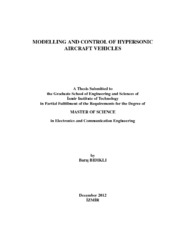Please use this identifier to cite or link to this item:
https://hdl.handle.net/11147/3534Full metadata record
| DC Field | Value | Language |
|---|---|---|
| dc.contributor.advisor | Tatlıcıoğlu, Enver | en |
| dc.contributor.author | Bıdıklı, Barış | - |
| dc.date.accessioned | 2014-07-22T13:51:45Z | - |
| dc.date.available | 2014-07-22T13:51:45Z | - |
| dc.date.issued | 2012 | en |
| dc.identifier.uri | http://hdl.handle.net/11147/3534 | - |
| dc.description | Thesis (Master)--Izmir Institute of Technology, Electronics and Communication Engineering, Izmir, 2012 | en |
| dc.description | Includes bibliographical references (leaves: 60-67) | en |
| dc.description | Text in English; Abstract: Turkish and English | en |
| dc.description | xv, 67 leaves | en |
| dc.description | Full text release delayed at author's request until 2016.01.07 | en |
| dc.description.abstract | The increasing number of works on hypersonics and the recent interest of Ministry of Defense on developing a hypersonic missile are amongst the main motivations behind this thesis. Research on hypersonics seems to divide into two main categories: deriving dynamic models for HSVs and designing model-based controllers. Initially, we decided to investigate the control problems associated with HSVs. However, due to the restrictions imposed by the leading sponsors of hypersonic research (such as NASA, US AF, US DoD, DARPA, etc), researchers did neither publish nor share the model parameters for HSVs. As a result, our initial focus was deriving a dynamic model for an HSV. Firstly, modelling approaches for HSVs and we noticed that it is extremely hard to directly obtain the HSV dynamic model parameters. In addition to this, the HSV nonlinear dynamic model which was commonly mentioned in the literature is not related to the control inputs directly. As a result, the linearized HSV dynamic models were investigated, and the linear parameter varying model was derived. Next, control problems associated with the HSVs are investigated. Due to the highly complicated and time-varying nature of their dynamics, designing a robust control law is aimed. The main reason behind choosing to design a robust control law was that the robust controllers usually require minimum knowledge about the HSV dynamics. The stability of the proposed robust control law is then investigated via Lyapunov-based techniques and the tracking error is driven to the origin exponentially fast by using designed controller. | en |
| dc.language.iso | en | en_US |
| dc.publisher | Izmir Institute of Technology | en |
| dc.rights | info:eu-repo/semantics/openAccess | en_US |
| dc.subject.lcsh | Hypersonic planes | en |
| dc.subject.lcsh | Robust control | en |
| dc.subject.lcsh | Lyapunov functions | en |
| dc.subject.lcsh | Nonlinear systems--Automatic control--Mathematics | en |
| dc.title | Modelling and control of hypersonic aircraft vehicles | en_US |
| dc.type | Master Thesis | en_US |
| dc.institutionauthor | Bıdıklı, Barış | - |
| dc.department | Thesis (Master)--İzmir Institute of Technology, Electrical and Electronics Engineering | en_US |
| dc.relation.publicationcategory | Tez | en_US |
| item.fulltext | With Fulltext | - |
| item.grantfulltext | open | - |
| item.languageiso639-1 | en | - |
| item.openairecristype | http://purl.org/coar/resource_type/c_18cf | - |
| item.cerifentitytype | Publications | - |
| item.openairetype | Master Thesis | - |
| Appears in Collections: | Master Degree / Yüksek Lisans Tezleri | |
Files in This Item:
| File | Description | Size | Format | |
|---|---|---|---|---|
| 452765.pdf | MasterThesis | 1.48 MB | Adobe PDF |  View/Open |
CORE Recommender
Page view(s)
196
checked on Nov 18, 2024
Download(s)
216
checked on Nov 18, 2024
Google ScholarTM
Check
Items in GCRIS Repository are protected by copyright, with all rights reserved, unless otherwise indicated.